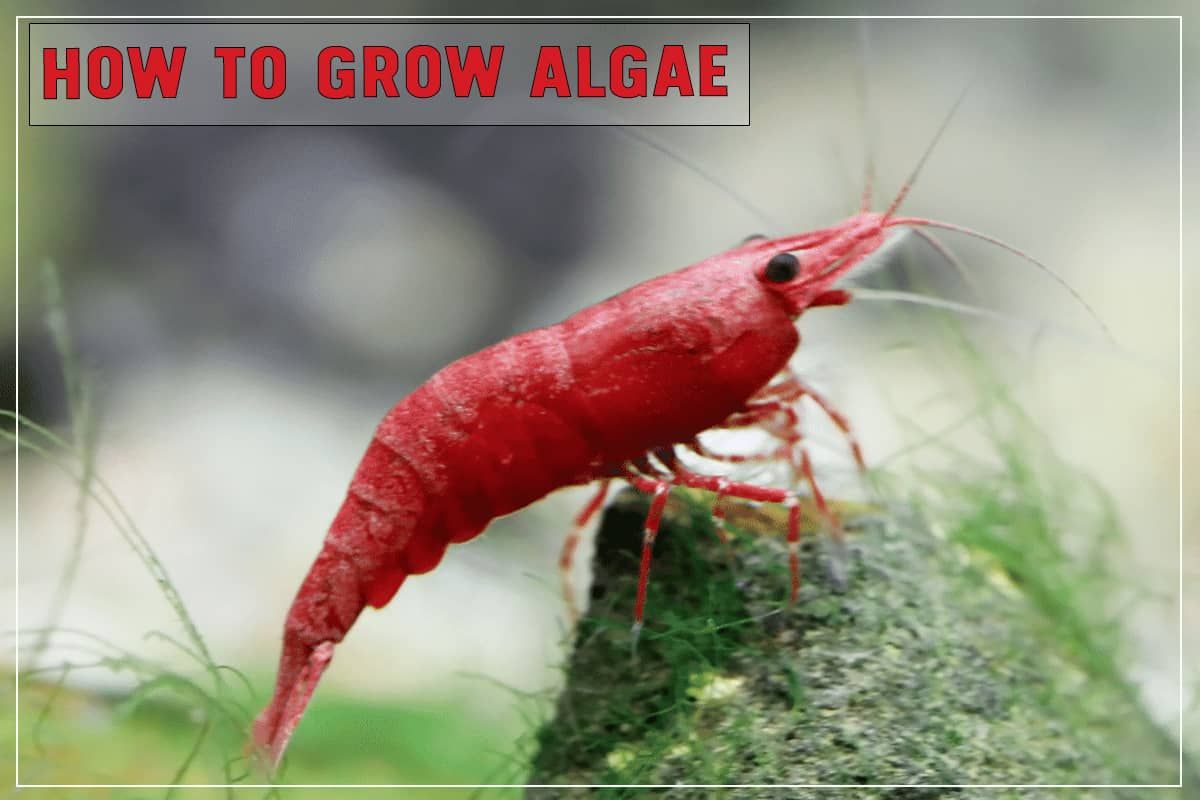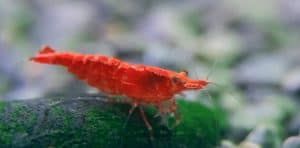
Let’s skip the introduction and get right to the point – how to grow algae for shrimp.
In a nutshell, algae require a wide variety of chemical elements and specific conditions for growth and reproduction where light imbalance and light imbalance (specifically nitrogen and phosphorous) play the most important role.
Even though the process may seem pretty straightforward, it is more complicated than you think! There are two main problems here.
First, algae are caused by the imbalance of nutrients, light, etc., whereas dwarf shrimp require a stable environment.
Second, we cannot be absolutely sure what kind of algae we may get. It can be either beneficial for our shrimp or completely useless (uneatable).
First of all – Why Algae?
In the wild, according to studies, algae are one of the most important natural sources of food for shrimp. Algae were found in 65% of shrimp guts. This is one of the most important sources of their food.
Note: Generally, algae, detritus, and biofilm constitute their natural diet.
Important: Should I Grow Intentionally Algae in Shrimp Tank?
Many new shrimp keepers are very excited to create the best possible conditions for their shrimp. So, when they find out about algae they immediately jump into action not realizing that they might be ruining their tanks.
Remember, our tanks are unique! Nutrition, water volume, water quality, temperature, lighting, lighting intensity, lighting duration, plants, driftwood, leaves, animals stocking, etc. are factors that will affect your results.
The better is the enemy of good.
In addition, not all algae are good – some species (such as Staghorn algae, Black beard algae, etc.) are not eaten by dwarf shrimp and may even produce toxins (blue-green algae).
Therefore, if you managed to have a well-balanced ecosystem where your water parameters are stable and your shrimp are happy and breeding, you should think twice thrice before changing anything.
Therefore, before you decide whether it is worth growing algae in shrimp tank or not, I strongly encourage you to be very careful.
DO NOT simply change anything and potentially ruin your tank by thinking that you have to grow algae when you can easily buy shrimp foods.
What Affects the Grow of Algae in Aquariums
Many reports have revealed that the abundance of algae in a shrimp tanks can vary with changes in environmental factors such as:
● nutrient level,
● light,
● temperature,
● water movement,
● pH,
● oxygen.
These are the main things that affect the growth of algae.
1. Nutrient level (Nitrate and Phosphate)
Each algae species requires a wide variety of chemical elements (nutrients)to enable them to grow abundantly. Nonetheless, the most important are nitrogen (nitrates) and phosphorous for growth and reproduction.
Tip: Most live plant fertilizers contain nitrogen and phosphate. Therefore, adding a little bit of aquarium fertilizer to your tank will increase the growth rate of algae. Just be careful with copper in fertilizers; dwarf shrimp are very sensitive to it.
Related article:
● Shrimp Safe Plant Fertilizers
1.1. Nitrates
Nitrates are all by-products of organic waste breaking down in our tanks.
Basically, every time we feed our shrimp, snails, etc., they are going to produce waste in the form of ammonia. Eventually, ammonia turns into nitrites and nitrites into nitrates.
Important: In terms of concentration, nitrates should never be higher than 20 ppm in shrimp tanks. However, for breeding tanks, we need to keep nitrates below 10 ppm all the time.
Related articles:
● Nitrates in Shrimp Tank. How to Lower them.
● Everything about Nitrates in Planted Tanks
1.2. Phosphates
If there are not many plants in the shrimp tank, we can keep the phosphate levels in the 0.05 -1.5mg/l range. However, in planted tanks, the concentration should be only a little bit higher, to avoid competition with plants.
The main point is that algae cannot absorb more than they are capable of. Therefore, there is no need to have too much phosphates.
Phosphate is the natural form of phosphorus which is a nutrient used extensively by all organisms including algae. This is commonly the limiting nutrient for algal growth in freshwater tanks.
The main cause of algae is an imbalance of nutrients. That is why additions of phosphate can also increase algae growth.
The main sources of phosphates in our tanks include:
● fish/shrimp foods (especially frozen ones!),
● chemical (pH, KH) buffers,
● plant fertilizers,
● aquarium salts,
● water itself can contain significant levels of phosphates. Check out a water quality report, if you are on a public water source.
Related article:
● Phosphates in Freshwater Tanks
2. Lighting
If you have been in aquarium hobby even for a bit, you probably know this warning that excessive lights cause algae to grow in our tanks.
Important: Even though dwarf shrimp are nocturnal animals, different experiments and observations showed that they have a better survival rate at normal day and night cycles.
Of course, shrimp can live even without light or under constant light, but they will be very stressed in such aquariums.
Well, this is what we need. Increase photoperiod and lighting intensity.
If you maintain a standard photoperiod of around 8 hours daily, make it a 10 or 12-hour long. Give algae bright light per day and they will comfortably grow.
Related article:
● How Light Affects Dwarf Shrimp
3. Temperature
Important: DO NOT increase the temperature in shrimp tanks so much that they get uncomfortable. Ideally, you should NEVER play with temperature because such changes can cause preliminary molts. Obviously, this is very bad for the shrimp.
Also keep in mind that high temperature affects shrimp’s metabolism (shortening their lifespan), breeding, and even gender. You can read more about this in my articles.
In general, warmer temperatures allow algae to grow thicker and faster.
According to the study, temperature strongly influences the cellular chemical composition, uptake of nutrients, CO2, and growth rates for every species of algae. The optimal temperature range for algae growth should be within 68 – 86 °F (20 to 30°C).
4. Water Movement
Water flow does not encourage algae to grow. But, stagnant water encourages the proliferation of algae.
Important: DO NOT reduce it too much since your shrimp (like all animals) still need oxygenated water from the oxygen provided by either your filter, air stone, or air pump to live.
Therefore, tanks with reduced water movement will have better algae growth.
5. pH
Most algae species prefer alkaline water. According to the study, algae thrive in water with high pH levels between 7.0 and 9.0.
Important: NEVER, I repeat NEVER change your pH on purpose simply to grow more algae. This is a sure way to disaster in your shrimp tank.
Note: In algae blooming water, the pH may even vary during day and night time since algae remove carbon dioxide from the water. It can be maybe particularly noticeable if the buffering capacity (KH) is low.
6. Oxygen
Actually, this environmental factor works in combination with nitrogen and temperate because nitrogen and phosphate levels are naturally controlled through dissolved oxygen.
To decompose, the materials require oxygen. High temperature increases the decomposition rate.
If there is too much decomposing waste in your tank, the natural oxygen levels will drop (sometimes even significantly). As a result, nitrogen and phosphate levels will also rise.
This increase in nutrients will cause aggressive algal blooms.
TIP: If you are planning to grow algae in aquariums, you need to avoid using UV sterilizers and CO2 injections as well.
Also, when the algae eventually die, the oxygen in the water is consumed. The lack of oxygen makes it dangerous for any aquatic life to survive. In its turn, it only leads to more algae.
Growing Algae Outside of the Shrimp Tank

Now, after reading all these scary things, growing algae on purpose in shrimp tanks does not look very tempting. Right?
So what can we do instead?
We can grow algae outside of our tanks. The easiest and safest way to do that is to use rocks in a separate container. We can see what kind of algae grows before we put it into our tanks.
1.You need some kind of transparent container (large bottle, spare tank, etc.).
2.Fill it with water. Use the water that comes from water changes.
Important: Do not use tap water! Nearly all tap water contains chlorine because it is the main disinfection method for city water supplies. Chlorine is known to be one of the best algae killers. However, it dissipates almost fully in 24 hours.
3.Put there a lot of rocks (like marble chips) and ceramic filter media (The rocks should be clean and aquarium safe, of course).
4.Place the container with rocks in warm areas and under the strongest lighting you can find. Ideally – 24/7.
Note: Sunlight is the obvious ‘natural’ choice for growing algae. However, indirect sunlight with artificial LED light is great. Overheating should be avoided as well.
5.Add some source of nitrogen (ammonia, shrimp food, etc.) or use any fertilizer to grow plants in a tank.
6.Aeration is helpful but not necessary.
7.Generally, it takes 7 – 10 days for the rocks to turn.
8.Take a few rocks and place them in the tank.
9.Replace the rocks when they are clean.
F.A.Q.
What kind of algae do shrimp prefer?
The common green algae are what you really want for the shrimp tanks. Most shrimp species do not eat the very tough algae that grow in long strings.
I do not see lots of algae in my shrimp tank, is it bad?
No, it is not. Perhaps your shrimp are eating the algae faster than it grows, so you never see it.
I have algae in my shrimp tank, is it imbalanced?
Having algae in the tank does not mean that your shrimp tank is imbalanced. Algae are natural components of any freshwater ecosystems and form the foundation of most aquatic food chains.
However, excessive growth rates with unstable water parameters are bad signs and should be addressed immediately.
Why do I get cynobacteria in my tank?
As a result of some tests and experiments, aquarists noticed that cynobacteria (blue green algae) start growing more than phosphates and nitrates have less than a 1:5 ratio.
As with plants, green algae prefer about 1 part phosphates to 10 parts nitrates.
I have brown algae in my tank.
Generally, brown algae grow in new (during the first month or two after setup) freshwater aquariums. It means that there is an abundance of nutrients, light, and silicates that fuel their growth. If your tank is full of silicate, you will see diatom bloom.
At this stage, this is normal. Eventually, it will be replaced by green algae that predominate in mature setups.
How to safely grow algae in a shrimp tank?
If I still needed to improve algae growth in the shrimp tank, the only thing that I would change is the lighting.
I would increase the photoperiod by 1 hour each week until I reach my goal. This is, probably, the safest method to grow algae in the tank itself.
Besides that, I would not change anything else. It can be too risky for the shrimp.
In Conclusion
Except for shrimp keepers, most aquarists consider algae to be the bane of this hobby. Naturally growing algae are the best food shrimp can get.
Nonetheless, even shrimp keepers should be very careful if they decide to grow algae on purpose since algae prefer an imbalanced environment.
As a result, the growth mechanism of algae becomes pretty complicated in shrimp tanks that require stability.
Many studies have shown that stagnant water combined with lots of light, warm temperatures and nitrogen, and phosphate concentrations (water quality in general), encourage the proliferation of algae.
Post time: Sep-06-2023
